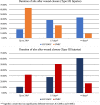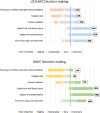Open tibial shaft fractures: treatment patterns in sub-Saharan Africa
- PMID: 36919118
- PMCID: PMC10005832
- DOI: 10.1097/OI9.0000000000000228
Open tibial shaft fractures: treatment patterns in sub-Saharan Africa
Abstract
Objective: Open tibial shaft fractures are a leading cause of disability worldwide, particularly in low and middle-income countries (LMICs). Guidelines for these injuries have been developed in many high-income countries, but treatment patterns across Africa are less well-documented.
Methods: A survey was distributed to orthopaedic service providers across sub-Saharan Africa. Information gathered included surgeon and practice setting demographics and treatment preferences for open tibial shaft fractures across 3 domains: initial debridement, antibiotic administration, and fracture stabilization. Responses were grouped according to country income level and were compared between LMICs and upper middle-income countries (UMICs).
Results: Responses from 261 survey participants from 31 countries were analyzed, with 80% of respondents practicing in LMICs. Most respondents were male practicing orthopaedic surgeons at a tertiary referral hospital. For all respondents, initial debridement occurred most frequently in the operating room (OR) within the first 24 hours, but LMIC surgeons more frequently reported delays due to equipment availability, treatment cost, and OR availability. Compared with their UMIC counterparts, LMIC surgeons less frequently confirmed tetanus vaccination status and more frequently used extended courses of postoperative antibiotics. LMIC surgeons reported lower rates of using internal fixation, particularly for high-grade and late-presenting fractures.
Conclusions: This study describes management characteristics of open tibial shaft fractures in sub-Saharan Africa. Notably, there were reported differences in wound management, antibiotic administration, and fracture stabilization between LMICs and UMICs. These findings suggest opportunities for standardization where evidence is available and further research where it is lacking.
Level of evidence: VI-Cross-Sectional Study.
Keywords: antibiotic prophylaxis; fracture fixation; low-resource setting; practice patterns; sub-Saharan Africa; tibial fractures; debridement.
Copyright © 2023 The Authors. Published by Wolters Kluwer Health, Inc. on behalf of the Orthopaedic Trauma Association.
Conflict of interest statement
The authors report no conflict of interest.
Figures





References
-
- Harris AM, Althausen PL, Kellam J, et al. . Lower Extremity Assessment Project (LEAP) study group. complications following limb-threatening lower extremity trauma. J Orthop Trauma. 2009;23:1–6. - PubMed
-
- Kohlprath R, Assal M, Uçkay I, et al. . Open fractures of the tibia in the adult: surgical treatment and complications. Rev Med Suisse. 2011;7:2484–2488. - PubMed
-
- Moroz PJ, Spiegel DA. The World Health Organization's action plan on the road traffic injury pandemic: is there any action for orthopaedic trauma surgeons? J Orthop Trauma. 2014;28(suppl 1):S11–S14. - PubMed
LinkOut - more resources
Full Text Sources
Research Materials
